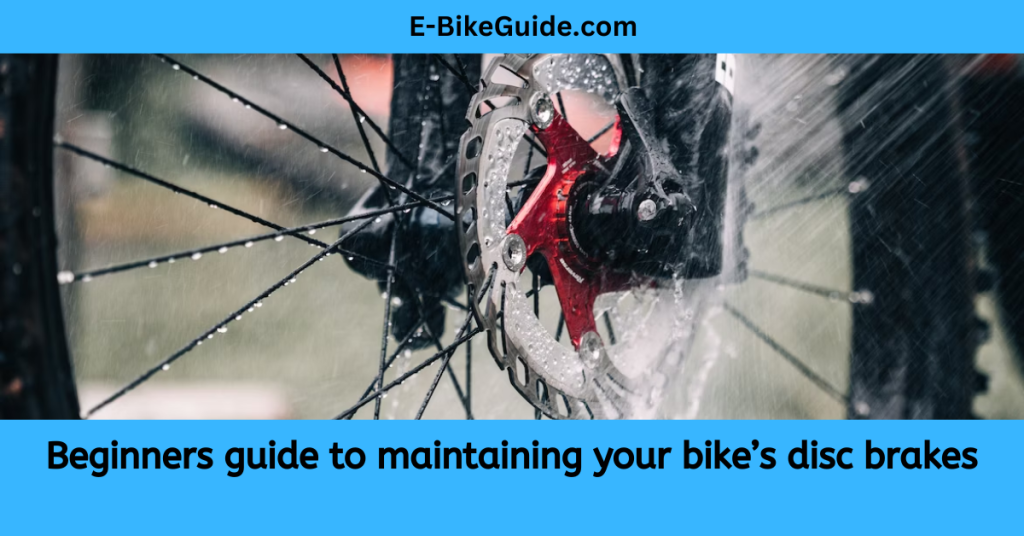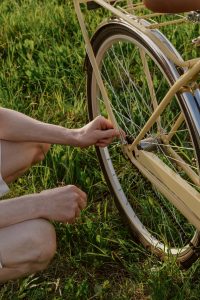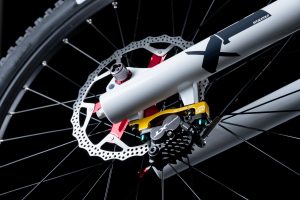Bicycles which are also called bikes are a common choice of transport nowadays. Because bicycles are way more eco-friendly, they catch the interest of many. In the Netherlands, most people use bicycles for transportation. The government itself motivates citizens to use bicycles instead of motor vehicles. Emissions from motor vehicles lead to the greenhouse effect in the atmosphere. It results in global warming which causes many bad impacts on the earth and us.
 People have come to consider the possible alternatives to mitigate the bad impacts of excessive fuel consumption. Using bikes for day-to-day transportation instead of motor vehicles is advantageous for the environment. Apart from that, it helps us to ensure our physical fitness. Considering the numerous advantages, people are now switching to bikes more and more. Statistics estimate that people are using around 1 billion bicycles globally. Apart from the Netherlands, countries like Italy, France, Belgium, and New Zealand also encourage using bicycles.
People have come to consider the possible alternatives to mitigate the bad impacts of excessive fuel consumption. Using bikes for day-to-day transportation instead of motor vehicles is advantageous for the environment. Apart from that, it helps us to ensure our physical fitness. Considering the numerous advantages, people are now switching to bikes more and more. Statistics estimate that people are using around 1 billion bicycles globally. Apart from the Netherlands, countries like Italy, France, Belgium, and New Zealand also encourage using bicycles.
Anybody can buy a bike if they have enough money. Even kids today have bicycles. However, taking care of your bike is important. Proper maintenance will lead to a longer lifecycle of your bike. Poor maintenance will lead to constant breakdowns and quick disposal of the bike. Since a bike is an assembly of several parts, each part needs care and maintenance.
Different types of bikes in the market
When it comes to bikes, there are many to choose from. You just have to pick what’s best for you. It depends on your purpose and personal preference as well. You can ask some questions from yourself and take a sophisticated decision. Here are some questions to ask.
- Where are you going to go with the bike?
- With whom you are going on rides?
- If you are riding with colleagues, what are they riding?
- Where do you expect to go with your new bike?
- What are the bikes you earlier had?
- Is there any bike you especially like?
- Are there any special features you don’t like about bikes?
After asking yourself the appropriate questions, you may decide what you want. If you are purchasing a bike to go to school with your gang of friends, you need something to keep up with them. If they are having road bikes, you may purchase a road bike. For your requirement, a mountain bike is not the most appropriate option. Think you need a bike to travel in the countryside through rocky and bumpy roads. For that, a mountain bike will be the best option. If you are looking for a bike to ride a long trip, a touring bike will do the job.
Here are some bike options for you to choose from.
- Road bikes – For road pavements and general rides
- Mountain bikes – For rough off-road rides
- Cyclocross bikes – For mixed surfaces
- Touring bikes – For long trips
- Track bikes – For races
- Hybrid bikes – Have both mountain and road bike features
- Cruiser bikes – Similar to hybrid
- Folding bikes – Foldable
- Recumbent bikes – Have back support
- Tandem bikes – For two people
- Tricycles – For adults and have three wheels
Different parts of a bike
A bike is an assembly of different parts. And each of these parts is essential and have own specific purpose. The overall mechanism behind a bike is forcing the wheels to rotate and move forward by pedaling. Though it seems simple, it involves the proper collaboration of all parts constituting the bike. Here are some of the bike parts.
- Pedals – This is where the rider places his feet. The rider needs to rotate the pedals so that the chain spins and powers the bike.
- Front derailleur – This is the mechanism to shift the chain from one chainring to another.
- Chain – A roller chain transferring power from the pedals to the back wheel.
- Chain stay – A pair of metal tubes connecting the bottom bracket to the rear axle holders.
- Rear derailleur – This is the mechanism to shift the chain at the rear sprockets.
- Rear and front brakes – Provides stability and lock up every time you hit the brake pedal.
- Seat – This is where you sit during your bike ride.
- Seat post – Supports the seat and is adjustable. You can adjust it to your convenient height.
- Crossbar – The horizontal metal bar between the handlebars and the saddle.
- Tire – A ring-shaped thing surrounding the wheel’s rim. And transfer vehicle load from the axle through the wheel to the ground.
- Tire valve – Air enters the tire through this. You need to close it well so that no air escapes.
- Rim – A large hoop attached to the outer ends of the spokes of the wheel holding the tire and the tube.
- Spoke – The metal rods radiating from the center of a wheel. And connects the hub and the rim.
- Hub – The center part of a wheel.
- Brake lever – Lever on the handlebar.
- Handlebar – Curved metal bar with handles to steer.
What is a brake in a bike?
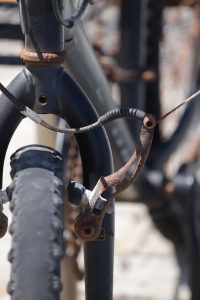 Among the several parts of a bike, brakes have their significance. A bike brake is to reduce the speed of the bike and eventually stops it. The brake system mainly composes of three mechanisms which are:
Among the several parts of a bike, brakes have their significance. A bike brake is to reduce the speed of the bike and eventually stops it. The brake system mainly composes of three mechanisms which are:
- A mechanism to activate the brake system – Brake lever on the handlebar
- A mechanism to transmit the signal – Brake cable
- A mechanism to stop the bike – Caliper, drum, or disc
Brakes carry a considerably big history with them. The origin of the brake mechanism was years ago. Karl Drais had to install a brake mechanism in his Laufmaschine. And it was a pivoting brake shoe to press against the rear tire. Since bicycles also need a brake system of their own, the spoon brake was introduced. Over years there were many developments and modifications to the brake system. Alternatively, people began using the caliper brake in the 1880s. The list goes on and on while following are some of the various types of brakes.
Spoon brakes
This is probably the first bicycle brake for bicycles. It comprises a leather pad or a rubber-faced metal shoe. And the rider needs to press the pad or the metal shoe at the front tire. A right-hand lever activates the brake system. However, these brakes are reactive to road conditions. Therefore, the tires may wear increasingly.
Duck brakes
Duck brakes use rubber rollers to stop the bike. The rubber rollers are pulled together at the front tire. And they activate by a rod that operates by a lever on the handlebar. Later, the duck brakes were enhanced to use for motorcycles too.
Rim brakes

As the name implies, rim brakes work on the rim of the bike wheel. The brake pads which activate by a brake lever in the handlebar stop the bike from moving. Rim brakes come in the following categories.
- Caliper brakes
- Cantilever brakes
- U brakes
- Roller-cam brakes
- Hydraulic rim brakes
Drum brakes
Drum brakes have drums rotating with the wheels. For the generation of braking force, the brake shoes have friction material pressed against the drums. A frictional force generates with the rubbing between the friction material such as brake linings and the drum surface. This friction force converts kinetic energy to thermal energy. And the wheel stops eventually. There are three types of drum brakes which are:
- Leading/trailing shoe type
- Twin leading shoe type
- Duo-servo type
Disc brakes
Disc brakes have brake rotors rotating with the wheels and brake pads. Brake pads are fitted to brake calipers, And when pushed against the rotors, they generate friction. Friction converts kinetic energy into thermal energy and stops the wheel. In the beginning, cars used disc brakes. They replaced drum brakes in the 1980s. Disc brakes catch more interest because they generate more stopping power than other brakes. They dominate both rim and drum brakes.
All about disc brakes on bikes
In the beginning, mostly mountain bikes had disc brakes while over time all bikes began using them. Some were confused with using disc brakes but the enormous stopping power with disc brakes dominates other brakes. Disc brakes perform equally during all weather conditions. Disc brakes come in two types.
- Mechanical disc brakes – Involves a brake cable.
- Hydraulic disc brakes – Involves a hydraulic fluid to transfer force.
The mechanism with disc brakes starts with applying brakes using the brake lever on the handlebar. The mechanism is almost similar to rim brakes. What changes in the case of disc brakes is where braking force applies. For rim brakes, it was the rim of the wheel while in disc brakes, the force applies to the rotor at the center of the wheel.
What makes disc brakes more significant than others is the considerably high-power generation with disc brakes. Since the braking power is quite high, it makes the rider force less on the brake lever. No need to apply a large force to stop the bike. It is an advantage for the rider as it results in less fatigue. Other than the high braking power, disc brakes are reliable in all kinds of weather. They perform equally during all weather conditions such as winter, rain, or sunny weather.
When it comes to the two types of disc brakes, mechanical and hydraulic, you can decide what to choose. Think you are running low on your budget and still prefer a bike that performs better in all weather conditions. For this reason, you may choose a bike with mechanical disc brakes. They are less costly but give you many advantages. If you are okay with a little high cost, you may choose hydraulic disc brakes.
Disc brake maintenance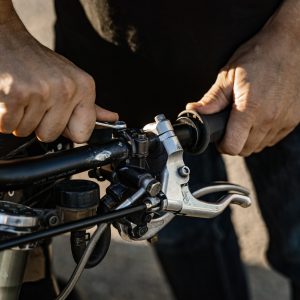
Over time, brakes get spongy and will not respond as soon as they were in the beginning. These are usually the results of small air bubbles stuck inside the brake system. However, these kinds of issues are particularly common with hydraulic disc brakes. Hydraulic disc brakes involve a hydraulic fluid inside the system while mechanical disc brakes don’t.
But mechanical disc brakes are also not 100% fault-proof. They involve cables in the brake system. And these cables need daily care. They are prone to contamination as well as cable breaking. In case of such problematic situations, you will have to address the situation as quickly as possible. Daily maintenance of the brake cables will do much good for the long life of your bike. A plus point of mechanical disc brake bikes is that you can manage the basic problems of your bike mostly at home.
When a brake needs to be bled in case air bubbles are trapped in the system, you need technical expertise. You can go for a bike mechanic. It requires the correct fluid and some other tool kits. You don’t have any of this at home. You have to repeat the bleeding of hydraulic disc brakes every six months. The process may be costly but it’s good for your bike if you go to a mechanic.
Disc brake calipers
Brake levers connect to the calipers through the brake lines. Calipers are there on both the front and rear discs. And have pistons sitting on either side of the rotor. When the brake lever activates, the brake line is under force. The force then activates the pistons and moves the brake pads to touch the disc. A frictional force generates which decelerates and stops the bike.
Disc brake caliper maintenance
If you notice some kind of rubbing, grinding, or squealing, you should take a look at your bike’s caliper. The rotor is not rotating freely anymore because the caliper is not aligned properly. In such a situation you can resolve the problem. You have to loosen the 2 bolts which hold the caliper to the bike frame. It’s okay if the bolts are loose enough to move the caliper sidewise. Check whether the caliper can move freely and then apply brakes through the brake lever. It will clamp the caliper to the rotor. Then tighten the top and bottom bolts while ensuring the caliper doesn’t move. Retighten the top bolt to torque spec and then the bottom bolt.
Disc brake rotors
A disc brake rotor rotates with the wheel and is clamped by brake pads fitted to the caliper from both sides. Rotors for road bikes and cyclocross bikes are pretty small. Their diameter is about 140 mm. Rotors for mountain bikes have large diameters of around 205 mm. For trail riding, rotors of diameter 160-180 mm are used.
Disc brake rotor maintenance
If you are still experiencing some rubbing even after adjusting the caliper, there may be something wrong with the rotor. Rotors change shape sometimes. They warp because of high heat or any accidental hitting. You can check for any warp in your bike rotor by making the wheel rotate. If it is warped, you can easily bend it back with a rotor truing tool.
Disc brake pads
Disc brake pads are within the calipers. Their task is to control the effects of heat and friction apart from stopping the bike.
Disc brake pad maintenance
If your bike makes further noise or squeals when brakes are applied, even after checking the caliper and rotor, something is wrong with the brake pads. Maybe it is contaminated. You must clean it. Separate the wheel and use a rag with some isopropyl alcohol to clean the surface.
Conclusion
The market gives us many different options of bikes to choose from. Over the years people have become more interested in bikes because of their advantages. Bikes are good for our health as well as the environment.
However, if you want your bike to last long with you, it needs proper maintenance. Every single part of the bike needs special care. Disc brakes compose of calipers, rotors, and brake pads. Each of these items requires maintenance in a way specific to either of them. Always try to carry on with daily maintenance when it comes to your bike.
